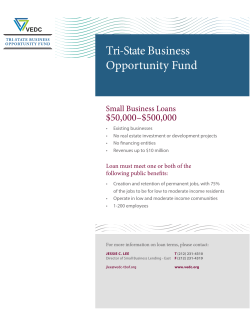
Retirement Withdrawal Rates
Retirement Withdrawal Rates Medallion Wealth Management, Inc. 2605 Nicholson Road Building 2, Suite 2103 Sewickley, PA 15143 724-934-8600 www.medallion-wealth.com During your working years, you've probably set aside funds in retirement accounts such as IRAs, 401(k)s, and other workplace savings plans, as well as in taxable accounts. Your challenge during retirement is to convert those savings into an ongoing income stream that will provide adequate income throughout your retirement years. October 1994; Jonathan Guyton, "Decision Rules and Portfolio Management for Retirees: Is the 'Safe' Initial Withdrawal Rate Too Safe?" Journal of Financial Planning, October 2004) Conventional wisdom In addition, inflation may have a greater impact on retirees. That's because costs for some services, such as health care and food, have risen more dramatically than the Consumer Price Index (the basic inflation measure) for several years. As these costs may represent a disproportionate share of their budgets, retirees may experience higher inflation costs than younger people, and therefore might need to keep initial withdrawal rates relatively modest. Still other experts suggest that our current environment of lower government bond yields may warrant a lower withdrawal rate, around 3%. (Source: Blanchett, Finke, and Pfau, "Low Your retirement lifestyle will depend not only on Bond Yields and Safe Portfolio Withdrawal your assets and investment choices, but also Rates," Journal of Wealth Management, Fall on how quickly you draw down your retirement 2013) portfolio. The annual percentage that you take Don't forget that these hypotheses were based out of your portfolio, whether from returns or the on historical data about various types of principal itself, is known as your withdrawal investments, and past results don't guarantee rate. Figuring out an appropriate initial future performance. withdrawal rate is a key issue in retirement Inflation is a major consideration planning and presents many challenges. Why is your withdrawal rate important? An initial withdrawal rate of, say, 4% may seem relatively low, particularly if you have a large Take out too much too soon, and you might run portfolio. However, if your initial withdrawal rate out of money in your later years. Take out too is too high, it can increase the chance that your little, and you might not enjoy your retirement portfolio will be exhausted too quickly, because years as much as you could. Your withdrawal you'll need to withdraw a greater amount of rate is especially important in the early years of money each year from your portfolio just to your retirement, as it will have a lasting impact keep up with inflation and preserve the same on how long your savings will last. purchasing power over time. So, what withdrawal rate should you expect from your retirement savings? One widely used rule of thumb states that your portfolio should last for your lifetime if you initially withdraw 4% of your balance (based on an asset mix of 50% stocks and 50% intermediate-term Treasury notes), and then continue drawing the same dollar amount each year, adjusted for inflation. However, this rule of thumb has been under increasing scrutiny. April 2015 Retirement Withdrawal Rates When Your Child Asks for a Loan, Should You Say Yes? How Does Your 529 Plan Stack Up Against the Competition? I owe a large amount of money to the IRS. Can I pay what I owe in installments? Some experts contend that a higher withdrawal rate (closer to 5%) may be possible in the early, active retirement years if later withdrawals grow more slowly than inflation. Others contend that portfolios can last longer by adding asset classes and freezing the withdrawal amount during years of poor performance. By doing so, they argue, "safe" initial withdrawal rates above 5% might be possible. (Sources: William P. Bengen, "Determining Withdrawal Rates Using Historical Data," Journal of Financial Planning, Your withdrawal rate There is no standard rule of thumb. Every individual has unique retirement goals and means, and your withdrawal rate needs to be tailored to your particular circumstances. The higher your withdrawal rate, the more you'll have to consider whether it is sustainable over the long term. All investing involves risk, including the possible loss of principal; there can be no assurance that any investment strategy will be successful. Page 1 of 4 See disclaimer on final page When Your Child Asks for a Loan, Should You Say Yes? You raised them, helped get them through school, and now your children are on their own. Or are they? Even adult children sometimes need financial help. But if your child asks you for a loan, don't pull out your checkbook until you've examined the financial and emotional costs. Start the process by considering a few key questions. Why does your child need the money? Perhaps you have plenty of money to lend, and you're not earning much on it right now, so when your child asks for a loan, you think, "Why not?" But even if it seems to be the right thing to do, look closely at potential consequences before saying yes. Lenders ask applicants to clearly state the purpose for the loan, and you should, too. Like any lender, you need to decide whether the loan purpose is reasonable. If your child is a chronic borrower, frequently overspends, or wants to use the money you're lending to pay past-due bills, watch out. You might be enabling poor financial decision making. On the other hand, if your child is usually responsible and needs the money for a purpose you support, you may feel better about agreeing to the loan. financial decisions and feel obligated to give advice? Will you be okay with forgiving the loan if your child is unable to pay it back? And how will other family members react? For example, what if your spouse disagrees with your decision? Will other children feel as though you're playing favorites? If you decide to say yes Think like a lender Take your responsibility, and the borrower's, seriously. Putting loan terms in writing sounds too businesslike to some parents, but doing so can help set expectations. You can draft a loan contract that spells out the loan amount, the interest rate, and a repayment schedule. To avoid playing the role of parent-turned-debt collector, consider asking your child to set up automatic monthly transfers from his or her financial account to yours. Pay attention to some rules Will your financial assistance help your Having loan documentation may also be necessary to meet IRS requirements. If you're child in the long run? It's natural to want to help your child, but you also want to avoid jeopardizing your child's independence. If you step in to help, will your child lean on you the next time, too? And no matter how well-intentioned you are, the flip side of protecting your child from financial struggles is that your child may never get to experience the satisfaction that comes with successfully navigating financial challenges. Can you really afford it? Perhaps you can afford to lend money right now, but look ahead a bit. What will happen if you find yourself in unexpected financial circumstances before the loan is repaid? If you're loaning a significant sum and you're close to retirement, will you have the opportunity to make up the amount? If you decide to loan your child money, be sure it's an amount that you could afford to lose, and don't take money from your retirement account. What if something goes wrong? One potential downside to loaning your child money is the family tension it may cause. When a financial institution loans money to someone, it's all business, and the repayment terms are clear-cut. When you loan money to a relative, it's personal, and if expectations aren't met, both your finances and your relationship with your child may be at risk. lending your child a significant amount, prepare a promissory note that details the loan amount, repayment schedule, collateral, and loan terms, and includes an interest rate that is at least equal to the applicable federal rate set by the IRS. Doing so may help ensure that the IRS doesn't deem the loan a gift and potentially subject you to gift and estate tax consequences. You or your child may need to meet certain requirements, too, if the loan proceeds will be used for a home down payment or a mortgage. The rules and consequences can be complex, so ask a legal or tax professional for information on your individual circumstances. If you decide to say no Consider offering other types of help Your support matters to your child, even if it doesn't come in the form of a loan. For example, you might consider making a smaller, no-strings-attached gift to your child that doesn't have to be repaid, or offer to pay a bill or two for a short period of time. Don't feel guilty If you have serious reservations about making the loan, don't. Remember, your financial stability is just as important as your child's, and a healthy relationship is something that money can't buy. For example, how will you feel if your child treats the debt casually? Even the most responsible child may occasionally forget to make a payment. Will you scrutinize your child's Page 2 of 4, see disclaimer on final page How Does Your 529 Plan Stack Up Against the Competition? Mediocre investment returns, higher-than-average fees, limited investment options and flexibility--these factors might lead you to conclude that you could do better with another 529 plan or a different college savings option altogether. If you're one of the millions of parents or grandparents who've invested money in a 529 plan, now may be a good time to see how your plan stacks up against the competition. Mediocre investment returns, higher-than-average fees, limited investment options and flexibility--these factors might lead you to conclude that you could do better with another 529 plan or a different college savings option altogether. You can research 529 plans at the College Savings Plans Network website at collegesavings.org. If you discover that your 529 plan's performance has been sub-par, what options do you have? When changing your investment options, it's important to distinguish between your existing contributions and your future contributions. Most 529 college savings plans let you change the investment options for your future contributions at any time. So, for example, if you originally picked a more aggressive investment option, you can choose a different one (or more than one) for your future contributions. Once you decide on a new 529 plan, the rollover process is fairly straightforward. Call your existing 529 plan to see what steps are required; some plans may impose a fee for a rollover, so make sure to ask. Then call your new 529 plan and establish an account; your new plan should have a process in place to accept rollover funds. You must complete the rollover to the new 529 plan within 60 days of receiving a distribution from your former 529 plan to avoid paying a penalty. you more investment control The rules are stricter when it comes to your existing contributions. If you're unhappy with the investment performance of your current investment choices but don't want to switch plans completely (using the rollover option Roll over funds to a new 529 plan described earlier), 529 college savings plans One option is to do a "same beneficiary are federally authorized (but not required) to let rollover" to a different 529 plan. Under federal you change the investment options for your law, you can roll over the funds in your existing existing contributions twice per calendar year 529 plan to a different 529 plan (college (prior to 2015, the rule was only once per year). savings plan or prepaid tuition plan) once every Check to see whether your 529 plan offers this 12 months without having to change the flexibility. beneficiary and without triggering a federal Choose other savings options that give penalty. If your 529 plan investment returns have been lackluster, you might wonder whether you should continue putting money into your account. Although many 529 plans offer a range of investment options that you can pick from, you might decide that you'd like more control over your college investments. In that case, you might consider using an entirely different sayings option, such as a Coverdell education savings account, a custodial account, If you want to roll over the funds in your existing or an IRA, all of which let you choose your 529 plan to a new 529 plan more than once in a underlying investments. 12-month period, you'll need to change the As you evaluate your options, keep in mind that designated beneficiary to another qualifying any college investment strategy should be family member to avoid paying a federal reexamined periodically in light of new laws and penalty. As a workaround, you can change the changes in your individual circumstances. new beneficiary back to the original beneficiary Note: Investors should consider the investment later. objectives, risks, charges, and expenses Change your investment strategy in associated with 529 plans before investing. More information about specific 529 plans is your current 529 plan available in each issuer's official statement, Just because you can switch to a new 529 plan which should be read carefully before investing. doesn't necessarily mean you should. If the Also, before investing, consider whether your new 529 plan you're considering has roughly state offers a 529 plan that provides residents the same mix of investment choices and similar with favorable state tax benefits. As with other fees as your current plan, you might ask investments, there are generally fees and yourself whether you'd be better off staying put expenses associated with participation in a 529 and simply changing your current investment plan. There is also the risk that the investments allocations. This is especially true if you have may lose money or not perform well enough to invested in your own state's 529 plan and the cover college costs as anticipated. availability of related state tax benefits is contingent on you remaining in your state's plan. Page 3 of 4, see disclaimer on final page Medallion Wealth Management, Inc. 2605 Nicholson Road Building 2, Suite 2103 Sewickley, PA 15143 724-934-8600 www.medallion-wealth.com Securities offered through Cambridge Investment Research, Inc., a broker-dealer, member FINRA/SIPC. Advisory services offered through Cambridge Investment Research Advisors, Inc., a Registered Investment Adviser. Cambridge and Medallion Wealth Management, Inc. are not affiliated. Broadridge Investor Communication Solutions, Inc. does not provide investment, tax, or legal advice. The information presented here is not specific to any individual's personal circumstances. To the extent that this material concerns tax matters, it is not intended or written to be used, and cannot be used, by a taxpayer for the purpose of avoiding penalties that may be imposed by law. Each taxpayer should seek independent advice from a tax professional based on his or her individual circumstances. These materials are provided for general information and educational purposes based upon publicly available information from sources believed to be reliable—we cannot assure the accuracy or completeness of these materials. The information in these materials may change at any time and without notice. I owe a large amount of money to the IRS. Can I pay what I owe in installments? Unfortunately, not everyone gets a refund during tax season. If you are in the unenviable position of owing a large amount of money to the IRS, you may be able to pay what you owe through an installment agreement with the IRS. With an installment agreement, the amount of your payment will be based on how much you owe in unpaid taxes and your ability to pay that amount within the agreement's time frame. Although you are generally allowed up to 72 months to pay, your plan may be for a shorter length of time. To request an installment agreement, fill out Form 9465, Installment Agreement Request, and attach it to your tax return, or mail it by itself directly to your designated Internal Revenue Service Center. If your balance due is not more than $50,000, you can apply for an installment agreement online at IRS.gov. notice detailing the terms of your agreement. You will also be required to pay a fee of $120 ($52 if you make your payments by direct debit). You can make your payments by check, money order, credit card, payroll deduction, or direct debit from your bank account. Keep in mind that even if your request for an installment agreement is granted, you will still be charged interest and may be charged a late-payment penalty on any tax not paid by its due date. This interest and any applicable penalties will be charged until the balance you owe to the IRS is paid in full. It is important to realize that the fees and interest charged by the IRS for an installment agreement can add up. As a result, before you enter into an installment agreement, the IRS suggests that you consider other alternatives, such as getting a bank loan or using available credit on a credit card. The IRS will generally let you know within 30 days after receiving your request whether it is approved or denied (if you apply online, you'll get immediate notification of approval). If the request is approved, the IRS will send you a Will I have to pay a penalty tax if I don't have qualifying health insurance? It depends. One of the main objectives of the health-care reform law, the Patient Protection and Affordable Care Act (ACA), is to encourage uninsured individuals to obtain health-care coverage. As a result of the ACA, everyone must have qualifying health insurance coverage, qualify for an exemption, or pay a penalty tax. This requirement is generally referred to as the individual insurance or individual shared responsibility mandate. Health insurance plans that meet the requirements of the ACA generally include employer-sponsored health plans, government health plans, and health insurance purchased through state-based or federal health insurance exchange marketplaces. Individuals who are exempt from the individual insurance mandate include: • • • • Those who qualify for religious exemptions Certain noncitizens Incarcerated individuals Members of federally recognized American Indian tribes • Those who qualify for a hardship exemption Individuals may also qualify for an exemption if: • They are uninsured for less than three months • The lowest-priced insurance coverage available to them would cost more than 8% of their income • They are not required to file an income tax return because their income is below a specified threshold For tax year 2014, the penalty tax equals the greater of 1% of the amount of your household income that exceeds a specific amount (generally, the standard deduction plus personal exemption amounts you're entitled to for the year) or $95 per uninsured adult (half that for uninsured family members under age 18), with a maximum household penalty of $285. In 2015, the percentage rate increases to 2%, the dollar amount per uninsured adult increases to $325, and the maximum household penalty increases to $975. Page 4 of 4 Prepared by Broadridge Investor Communication Solutions, Inc. Copyright 2015
© Copyright 2025









